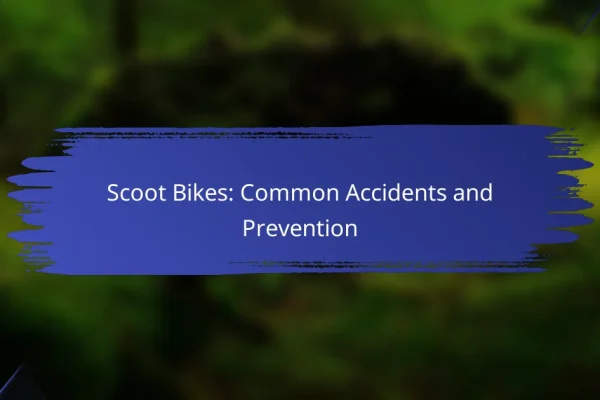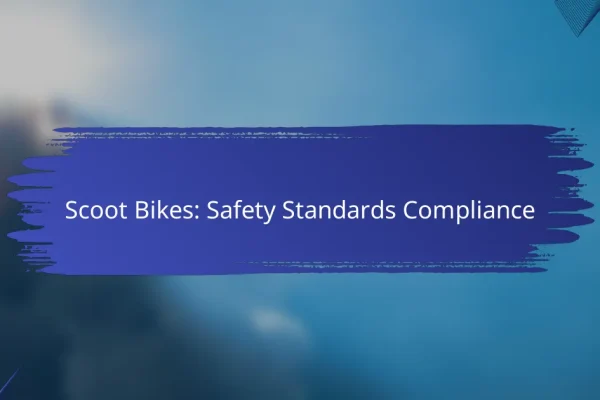What are the essential scoot bike safety guidelines?
The essential scoot bike safety guidelines focus on protecting the rider and ensuring safe navigation in traffic. Adhering to these practices can significantly reduce the risk of accidents and injuries.
Wear a helmet
Wearing a helmet is crucial for protecting your head in case of falls or collisions. Choose a helmet that meets safety standards such as CPSC or ASTM, and ensure it fits snugly without being too tight.
Make it a habit to wear your helmet every time you ride, regardless of the distance or speed. This simple action can greatly reduce the severity of head injuries.
Use reflective gear
Using reflective gear enhances your visibility, especially in low-light conditions. Opt for clothing or accessories that have reflective strips or bright colors to make yourself more noticeable to drivers.
Consider wearing a reflective vest or armbands, particularly during dawn, dusk, or nighttime rides. This can significantly reduce the chances of accidents caused by poor visibility.
Follow traffic rules
Following traffic rules is essential for safe scoot bike riding. Adhere to all road signs, signals, and lane markings just as you would if driving a car.
Be aware of local regulations regarding scoot bike usage, such as designated bike lanes and speed limits. Ignoring these rules can lead to dangerous situations and potential fines.
Check brakes and tires
Regularly checking your brakes and tires is vital for safe riding. Ensure that your brakes are responsive and that your tires are properly inflated and free of wear.
Before each ride, perform a quick inspection: squeeze the brakes to test their effectiveness and check the tire tread for any signs of damage. This can prevent accidents caused by mechanical failures.
Use hand signals
Using hand signals communicates your intentions to other road users, enhancing safety. Signal your turns and stops clearly to alert drivers and pedestrians of your actions.
Practice using the standard hand signals: left arm extended for a left turn, right arm extended for a right turn, and a downward arm for stopping. Consistent signaling can help prevent misunderstandings on the road.
How to choose a safe scoot bike?
Choosing a safe scoot bike involves assessing various features that contribute to rider safety. Focus on safety certifications, the bike’s weight and size, and the effectiveness of its braking systems to ensure a secure riding experience.
Look for safety certifications
Safety certifications indicate that a scoot bike meets specific safety standards. Look for labels from recognized organizations such as ASTM or CPSC, which ensure the bike has undergone rigorous testing.
When shopping, check for additional certifications that may be relevant in your country, as these can vary. For instance, European models may carry CE markings, while those in the US might display compliance with federal safety regulations.
Consider weight and size
The weight and size of a scoot bike significantly affect its stability and maneuverability. A lighter bike can be easier to handle, especially for younger riders, while a heavier model may provide more stability at higher speeds.
Ensure the bike is appropriately sized for the rider. A general guideline is that the rider should be able to place both feet flat on the ground when standing next to the scoot bike. This helps in maintaining balance and control.
Evaluate braking systems
Braking systems are crucial for safe stopping. Look for scoot bikes equipped with reliable brakes, such as disc brakes or dual braking systems, which offer better stopping power compared to standard brakes.
Test the brakes before purchasing. Ensure they engage smoothly and effectively. A good rule of thumb is to check if the brakes can stop the bike within a few meters when applied at a moderate speed.
What are common safety hazards while riding a scoot bike?
Common safety hazards while riding a scoot bike include potholes and debris, wet or slippery surfaces, and distracted drivers. Each of these hazards can significantly increase the risk of accidents, making it crucial for riders to be aware and take precautions.
Potholes and debris
Potholes and debris on the road can pose serious risks to scoot bike riders. Hitting a pothole can cause loss of control or even lead to falls, while debris like rocks, branches, or litter can obstruct the path and create hazards. Riders should always scan the road ahead and maintain a safe distance from obstacles.
To minimize risks, consider using a scoot bike with good suspension to absorb shocks from uneven surfaces. Additionally, riding at a moderate speed allows for quicker reactions to sudden obstacles.
Wet or slippery surfaces
Wet or slippery surfaces can drastically reduce traction, increasing the likelihood of skidding or falling. Rain, ice, or even oil spills can make roads hazardous for scoot bike riders. It’s essential to adjust your riding style in these conditions by slowing down and avoiding sharp turns.
Wearing appropriate footwear with good grip can help maintain stability. If conditions are particularly poor, consider postponing your ride until the surface is safer.
Distracted drivers
Distracted drivers are a significant danger for scoot bike riders. Drivers who are texting, talking on the phone, or otherwise not paying attention may not see riders, leading to potential collisions. Always assume that drivers may not see you and take proactive measures to ensure your visibility.
Using reflective gear and bright colors can help increase your visibility. Additionally, riding defensively and being aware of your surroundings can help you anticipate and react to potential threats from distracted drivers.
How can you improve scoot bike visibility?
Improving scoot bike visibility is essential for safety, especially during low-light conditions. Key strategies include using lights, wearing bright colors, and riding in well-lit areas to ensure you are seen by others.
Install front and rear lights
Installing front and rear lights on your scoot bike significantly enhances your visibility to other road users. Front lights should be bright enough to illuminate your path, while rear lights should be red and easily noticeable from a distance.
Consider using LED lights, as they are energy-efficient and can last for many hours. Ensure that your lights are securely mounted and charged or have fresh batteries before each ride.
Use bright colors
Wearing bright colors while riding a scoot bike can greatly increase your visibility, especially in crowded or dimly lit environments. Opt for neon or reflective clothing that stands out against the background.
Accessories like helmets, vests, or backpacks in bright colors can further enhance your visibility. Avoid dark colors, particularly during dusk or dawn, when visibility is naturally reduced.
Ride in well-lit areas
Choosing to ride in well-lit areas is a practical way to improve your visibility and safety. Streets with adequate street lighting help you see and be seen, reducing the risk of accidents.
Plan your routes to include well-lit paths, especially during evening rides. Avoid isolated or poorly lit areas, as they pose higher risks for visibility and safety.
What are the local laws regarding scoot bike riding?
Local laws for scoot bike riding vary significantly by region, impacting where and how you can ride. It’s crucial to familiarize yourself with these regulations to ensure safety and compliance.
Helmet laws in California
In California, helmet use is mandatory for all riders under the age of 18. Riders aged 18 and older are encouraged to wear helmets for safety, but it is not legally required.
Choosing a helmet that meets safety standards, such as those set by the Consumer Product Safety Commission (CPSC), is essential. A properly fitted helmet can significantly reduce the risk of head injuries in case of an accident.
Sidewalk riding regulations in New York
In New York City, riding scoot bikes on sidewalks is generally prohibited, with exceptions for certain areas. Riders must use bike lanes or streets, adhering to traffic laws applicable to bicycles.
To avoid fines, familiarize yourself with local signage and regulations. Always yield to pedestrians and be mindful of your speed when riding in shared spaces.











